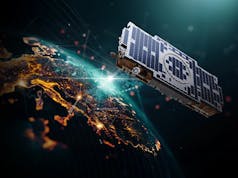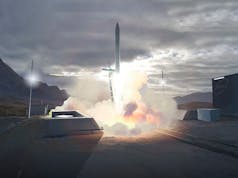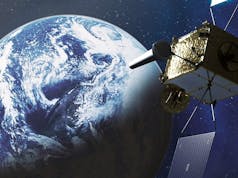The US president’s proposal for a Space Force earlier this summer included a statement that China and Russia cannot be allowed to make further gains in space at America’s expense.
This article was written by Rathna K. Muralidharan, a program director at the Lexington Institute with a focus on global security and regional politics. You can follow her at @RathnaKM and the Lexington Institute @LexNextDC.
Prioritising dominance in space in the face of our adversaries’ rapid advances is a topic that has received much advocacy from senior government officials for years. It is vital that the U.S. assure its superiority in space and is prepared to defend its interests against potential aggression.
The importance of superiority in space is a theme that senior Air Force officials have been emphasising recently. Secretary of the Air Force Dr. Heather Wilson, along with Air Force Chief of Staff General David Goldfein and three other senior officials, testified to the Senate Strategic Forces Subcommittee in May 2017 that space should be considered a warfighting domain and can no longer be viewed as a “benign environment” in which operational freedom is assured. The officials went on to stress the need to invest in modernising space systems to secure superiority in this new domain.
Expanding on this point at the Air Warfare Symposium 2018, General Goldfein stated that U.S. dominance in space must be pursued “with the same passion and sense of ownership” as air superiority. In an op-ed for Fox News published April 2018, Secretary Wilson wrote:
“Russia and China are developing anti-satellite capabilities that could become operational in the next few years. Our new National Defense Strategy correctly recognizes the reemergence of great power competition with China and Russia as the principal priority for the Defense Department.
We must continue to work with our allies to strengthen our collective self-defense in space, just as we have on Earth. And we must continue to study how our enemies might exploit vulnerabilities and how we will defeat them, just as military planners did before World War II.”
These threat perceptions are well-grounded; government agencies have been warning of China’s and Russia’s progress in space technology and policy for years. A 2015 Department of Defense report suggested that China is developing co-orbital anti-satellite systems to target U.S. space assets. In June 2018, the U.S. intelligence community warned that Russia and China are working on “destructive counterspace weapons” that will most likely be operational in the near future.
In his 2018 Worldwide Threat Assessment report to the Senate Armed Services Committee, Director of the Defense Intelligence Agency Lieutenant General Robert Ashley commented on Russia’s efforts in pursuit of space dominance:
“Moscow has concluded that gaining and maintaining supremacy in space will have a decisive impact on the outcome of future conflicts and is developing counterspace systems to hold U.S. space assets at risk. Russia will continue to pursue the development of a full range of ground-, air-, or space-based antisatellite weapons as a means to reduce U.S. military effectiveness and control the escalation of conflict if deterrence fails.”
Russia has been making moves to consolidate its space exploration and defence goals for years. In 2015, Moscow merged its space and air forces into the “Russian Aerospace Forces.” This move apparently sought to copy the U.S. Air Force’s structure, and consolidated authority to form a more integrated model for a unified aerospace theatre.
China and Russia are already well ahead of the U.S. in valuing space and developing technologies to achieve dominance. The U.S. must prioritise the development of technologies that will protect its assets in space and assure its superiority in this new domain. These new systems must address a variety of threats posed by factors on Earth and in space.
One such capability is more freedom to react in real time. Such a capability would enable systems to react more effectively to potential threats because they are not dependent on communication or direction from Earth. Products like BAE Systems’ SpaceNav GPS and onboard processing microprocessors give satellites and spacecraft more situational awareness to navigate space without relying on on-the-ground processing, providing the freedom to maneuver and respond instantaneously.
Read the full article, courtesy of RealClearDefense here.











Space, the final frontier. These are the voyages of the star ship Enterprise. It’s continuing mission … Sorry guys I’m a Trekkie couldn’t resist. Live long and prosper everyone.
Space the final frontier. These are the voyages of the star ship Enterprise. It’s continuing mission … Sorry guys i’m a Trekkie couldn’t resist. Live long and prosper.
Resistance is futile!
According to hacker Gary Mckinnon the US has already got a space force.
Lists of “non terrestrial officers” and USN ships that do not exist, which he suggests could be parts of a US Space Fleet already existent.
While I will not believe all that without evidence, I have no doubt a lot more goes on in space and near space than is publicly admitted, all part of the US DoD Black Budget.
Oh completely agree, look at the X-37.
There was said to be a much earlier version of the X-37. A mini space shuttle known as “Blue Eyes” back in the 80’s.
And how much of the SDI was actually continued despite its cancellation?
That’s what they want you to do.
Interesting. I hadn’t heard that bit of the Mckinnon story. Thanks Daniele.
I think it’s quite likely to be true. It doesn’t necessarily mean there are USN Death Stars floating around up there, the unaccounted-for USN ships could be something as underwhelming (relatively speaking) as unacknowledged X-37s or slightly more sophisticated versions thereof operating from undisclosed launch sites. Undisclosed space launch sites has been discussed for a while. If the “non terrestrial officers” bit is true though then it does imply a USN manned presence on orbit or further afield.
I can certainly imagine that technology that we’ve already seen come and go having in fact been retained and developed further by the US military. Another few decades of development on the manned space shuttle plus keeping the 1970s space station work (e.g. Skylab) running and evolving could have yielded interesting capabilities by now. Interesting stuff like Bigelow Aerospace making use of published NASA developments is already promising some interesting stuff in the space station area – http://bigelowaerospace.com/pages/b330/ . If there are any covert space stations up there I do wonder how they are kept hidden though. The ISS is hugely visible from earth so maybe these non terrestrial officers are flying mannes shuttles.
If it’s shuttles then it seems to me entirely possible that what is effectively Skylon is already in service. That could actually bring a smile to my face if the UK goes on to get Skylon up and running with key patents filed in favour of UK companies. That would have a nice symmetry with the case where crypotraphers at GCHQ first developed & demonstrated workable PK encryption within their classified environment only to have 3 US academics (Diffie, Hellman & Merkle) re-invent it a few years later and get all the glory and the patents. Such a Skylon development would be a payback of sorts for UK science & industry.
Thanks Julian. Good post. Agree the PK Encryption business annoys me. The UK has been a world leader in SIGINT back to Elizabeth 1st, through to GC&CS onwards to today.
I think such is the secrecy surrounding GCHQ advances in that field will often be attributed to NSA.
I think with many stories of the US Black Budget there’s no smoke without fire. Maybe not the starships and trips into the solar system rumoured but certainly manned spacecraft.
‘The Truth Is Out There ‘ – sorry I couldn’t resist either,yes id agree that the much vaunted Star Wars/SDI must have resulted in something tangible that was/is actually deployed in space.
Anything in orbit is visible from the ground or satellites, at one or more frequencies. There are no star destroyers or death stars at present. But we need to be ready for Russian, Chinese, and other satellite killers or even EMP weapons. I hope the UK develops Skylon instead of wasting the resources already invested.